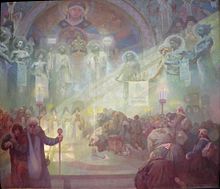Mount Athos
![]()
The title of this article is ambiguous. For other meanings, see Athos (disambiguation).
![]()
This article or subsequent section is not sufficiently supported by evidence (e.g., anecdotal evidence). Information without sufficient evidence may be removed in the near future. Please help Wikipedia by researching the information and adding good supporting evidence.
Extensive passages are completely free of evidence.
Template:Infobox State/Maintenance/TRANSCRIPTION
Template:Infobox State/Maintenance/NAME-German
Mount Athos (Ancient Greek Ἄθως Áthōs, Modern Greek Άθως Áthos; since Byzantine times usually Άγιον Όρος Ágion Óros, "Holy Mountain") is an Orthodox monastic republic with autonomous status under Greek sovereignty in Greece.
Geography
Mount Athos is located on the eponymous eastern finger of the Halkidiki peninsula in the region of Central Macedonia. The territory measures 43 kilometers from northwest to southeast and covers about 336 km²; it has 2262 (monastic) inhabitants plus administrative employees, police officers, business owners and a seasonally changing number of civilian workers. In common usage the term "(mountain) Athos" stands either for the whole peninsula Athos with the monk state or also only for the actual mountain at the southeast point of the peninsula which is 2033 meters high.
The peninsula, which is a maximum of 8.5 kilometres wide in the geographical sense, extends some 6.9 to 9 kilometres further west to the isthmus, which used to be bisected by the Xerxes Canal.
History
Even if the beginning of the history of the monasteries and monastic republics on Mount Athos is occasionally traced far back into the early Christian period, the first sure indications of monastic life on Mount Athos can probably only be traced to the beginning of the 9th century in Byzantine times.
The history of the Athos monasteries is closely connected with the dispute about the right monastic life, which flared up again and again in Orthodoxy - and precisely also on Mount Athos: the Hesychasm controversy between Hesychasts and Byzantine humanists. The spokesman for the hesychastic side was the Athos monk Gregorios Palamas (1296/1297-1359), who saw perfect inner peace (Greek ἡσυχία, hēsychía) in eremitical solitude through constant praying of the Jesus Prayer as a prerequisite for seeing the light of Jesus' transfiguration, the so-called "Tabor light." His theology provided hesychastic practice with its theoretical rationale and justification. Palamas defended hesychasm against the criticisms of Barlaam of Calabria, who, in the spirit of nominalistic humanism, criticized mystical practice and its justification through the writings of Gregorios Palamas. At several councils in Constantinople in the period from 1341 to 1351, the Byzantine Church decided first to condemn the opponents of Hesychasm and then to elevate the theoretical substantiation of Hesychasm by Gregorios Palamas ("Palamism") to binding church doctrine.
Since the 11th century Mount Athos had also great importance for the Christians of Kievan Rus. Monasteries were built for monks from Rus. From the 15th century the Moscow princes contributed to the financing of the monasteries and founded their own. From the 16th century they were subordinated to the Moscow Patriarchate.
At the turn of the 20th century, i.e. 550 years after the first major disputes, the theological dispute over Hesychasm between realists and nominalists, between rationalist theorists and theologians oriented towards mystical practice, found a continuation. It went down in the history of Athos and Orthodoxy as the dispute over the Imjaslavia movement, the worship of the name of God. The dispute contributed not insignificantly to the decline of the "Russian Mount Athos". Since the monks opposed the Holy Synod, the church leadership under state control in the Tsarist empire, the Russian ambassador in Istanbul, with the help of soldiers and firemen, had more than 1000 monks expelled from their monasteries and deported to Russia.

The holy mountain Athos as a destination of East Slavic pilgrims (picture from 1926 from the Slavic Epic by Alfons Mucha)
Search within the encyclopedia